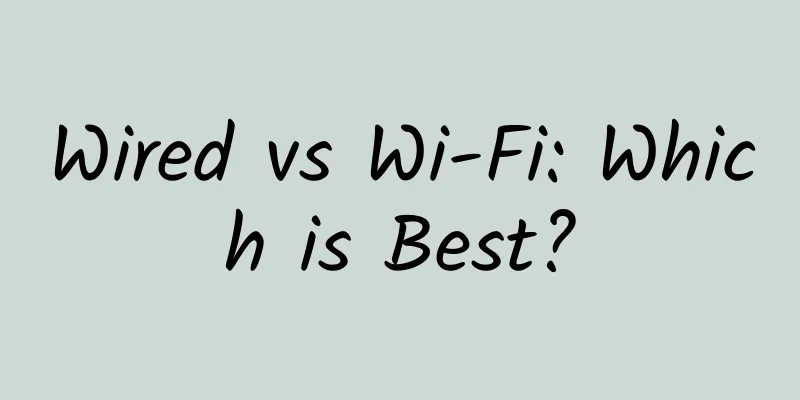Wired vs Wi-Fi: Which is Best?

|
The term Ethernet refers to a wired connection that transfers data via cables, while Wi-Fi refers to a wireless connection that uses radio waves to transfer data. Which is better? Ethernet and Wi-Fi each have strengths and weaknesses, so neither is better overall, but each is suitable for different use cases. What is Ethernet used for?Ethernet is a local area network (LAN) standard - the latest being IEEE 802.3ae - for connecting devices together in a physical space. Connections are made through LAN ports on devices using coaxial, twisted-pair, or fiber-optic cables (the three main types of Ethernet cables). (A misnomer, wireless Ethernet (WLAN) uses radio waves rather than cables to transmit data between devices, and is therefore a Wi-Fi setup.) Ethernet cables are used to connect devices such as computers or printers (usually within a LAN) to a network or wide area network (WAN) such as the Internet or within a WAN. Ethernet itself is not a LAN, it is a shared network limited to a specific geographic area that uses Ethernet to connect to the Internet or devices within its own network. For businesses, Ethernet is used to ensure secure communications, enable fast and stable connections, control which devices connect to the company network, and allow employees to share resources and download large files. In the industrial sector, Ethernet cables are used to securely connect machines and equipment during production processes on the factory floor. Industrial protocols such as EtherNet/IP connect edge devices to controllers such as programmable logic controllers (PLCs) and human-machine interfaces (HMIs). Single-Pair Ethernet (SPE) enables data transmission between field devices and the cloud. It uses a single pair of wires to transmit data at speeds of up to 1 Gbps over short distances. (Traditional Ethernet uses four twisted pairs.) SPE also supports Power over Data Lines (PoDL), which provides power to end devices at the same time. Ethernet's Advanced Physical Layer (APL) allows single-pair wiring of cables up to 1,000 m. On the home side, Ethernet connections are best for heavy-duty processing, such as gaming, data streaming, or downloading large files. What is Wi-Fi for?Wi-Fi is a communication protocol based on the IEEE 802.11x standard for implementing Wi-Fi networks. While Ethernet may be faster and more secure, Wi-Fi is a more attractive option for the average user. For example, Wi-Fi carries the majority of IP traffic at 70.6% due to its flexible connection options and portability. Wi-Fi is not limited to Internet use; it replaces cables and wires with radio signals and is used for many types of data exchange, such as streaming video between devices. How do Ethernet and Wi-Fi compete with each other?speedEthernet is faster. The numbers vary—depending on the cable used, for Ethernet, and for standard Wi-Fi—but speeds of up to 40 Gbps are possible with Ethernet using Cat8 cabling, and up to 10 Gbps with Wi-Fi. 5G, the latest 802.11 standard, is possible. (In reality, actual 5G speeds are much lower than those numbers.) 6G is still in the experimental stages and isn’t expected to be commercially available until around 2030, but 6G is expected to be up to 100 times faster than 5G. reliabilityEthernet signals do not fluctuate, unlike Wi-Fi signals which are susceptible to signal interference and disconnections, and weaken when passing through physical objects such as walls. Ethernet provides consistent communication and reduces latency. Ease of useEthernet can require extensive wiring and is complex and time-consuming to install and maintain. It requires a LAN port to connect devices. Mobility is limited by the length of the cable. Wi-Fi requires no cables or ports and is completely portable with no cable clutter. It requires an internal or external antenna. The good news is that modern Ethernet-based devices have built-in Wi-Fi that can be used simultaneously. While desktop computers have LAN ports, most modern mobile devices, such as laptops and tablets, do not. costFor basic installations, Ethernet is cost-effective to set up, but you can only set up one connection at a time for one device; the cost of wiring and switch boxes for multiple connections can add up. Most Wi-Fi devices have built-in antennas, and new connections can be easily added at no extra cost. However, using Wi-Fi may require boosting or extending the equipment to reduce signal interference, which is an additional cost. SafetyEthernet establishes a direct and secure connection to the network, which is why it has traditionally been widely used in the industrial sector. Since the development of IT/OT convergence in recent years, the biggest risk facing the industrial sector is security, and data on previously isolated Ethernet networks has become more vulnerable to cyber attacks. ScalabilityUnlike Ethernet, it is easy to connect multiple devices via a Wi-Fi network. Power over Ethernet (PoE)Ethernet allows power to be transferred from a computer to external devices such as cameras. Mobility and convenienceWi-Fi allows users to be completely mobile. It is also more convenient in a smart home without the clutter of cables. Ethernet users are physically limited by the length of the cables used. Final ThoughtsThe flexibility and convenience of Wi-Fi suggest that Wi-Fi may become the “better” overall choice in the future. Or will it? For many pundits, aside from the mobility factor, Ethernet’s advantages — speed, reliability, low latency and security — far outweigh Wi-Fi. Experts say future generations of Wi-Fi, even 7G with 100 Gbps speeds, are unlikely to completely replace Ethernet. In specialized industries such as oil and gas, utilities, telecommunications, and manufacturing, the cost and logistics of relocating millions of devices across geographic locations is prohibitive. And, like Wi-Fi, Ethernet is also evolving, albeit at a slower pace. Terabit Ethernet (TbE) could allow data transfer rates in excess of 100 Gbps in the future. As for which one is better: Currently, the choice is the convenience and faster speeds of wireless connections, and the more secure and reliable connection as long as you're close to a LAN. |
<<: Business Benefits of Fiber Optic Network Connectivity
>>: Will 5G play a big role in supporting the next generation of smart cities?
Recommend
Forgot your switch password? Don’t panic, here are detailed solutions!
It is said that many people are confused about th...
CMIVPS: Hong Kong high-bandwidth VPS hosting, 20% off for monthly payment, 30% off for half-year payment, direct line 5-100Mbps bandwidth
CMIVPS is a foreign hosting service provider esta...
Why do mobile network testers still pursue speed at all costs?
Communications operators must refocus on covering...
In the DT era, what is the trend of data center cabling?
As enterprises realize that structured cabling is...
ZJI: 580 yuan/month 2×E5-2630L, 32G memory, 480G SSD, 10M bandwidth, Hong Kong Confederation data center
ZJI is a well-known hosting company in the WordPr...
PhotonVPS: $4/month KVM-2GB/30GB/2TB/Los Angeles & Dallas & Chicago, etc.
It's been a long time since I shared the news...
30 countries will launch 5G services by 2023
New network deployments and enterprise momentum a...
The development trend of enterprise-level wireless coverage (WiFi6)
[[402903]] 1. Trends in enterprise-level wireless...
Regarding the ocean, we actually have a choice...
There are ten thousand ways for us to live in pea...
What happens when you enter a URL in the browser (Part 2): TCP module encapsulation and transmission mechanism
This series of articles will start with an introd...
5G networks and IoT: Research reveals cybersecurity risks
The researchers said the risks of 5G networks are...
RAKsmart Hong Kong VPS simple test, three network direct connection/Telecom CN2
A few days ago, we shared information about RAKsm...
HostXen offers 50 yuan for new user registration, 6GB memory package starts from 70 yuan/month, and data centers in the United States, Japan, Singapore, and Hong Kong are available
HostXen is offering a 50 yuan voucher to new user...
V5.NET launches new cloud servers with 20% discount starting from 20 yuan/month, with optional data centers in Hong Kong/Korea/Germany/Netherlands
V5 Server (V5.NET) previously mainly provided ind...
Standard Interconnect celebrates the launch of its self-developed public cloud system, and offers a 50% discount on telecom high-defense servers
Standard Interconnect is a Chinese hosting compan...









